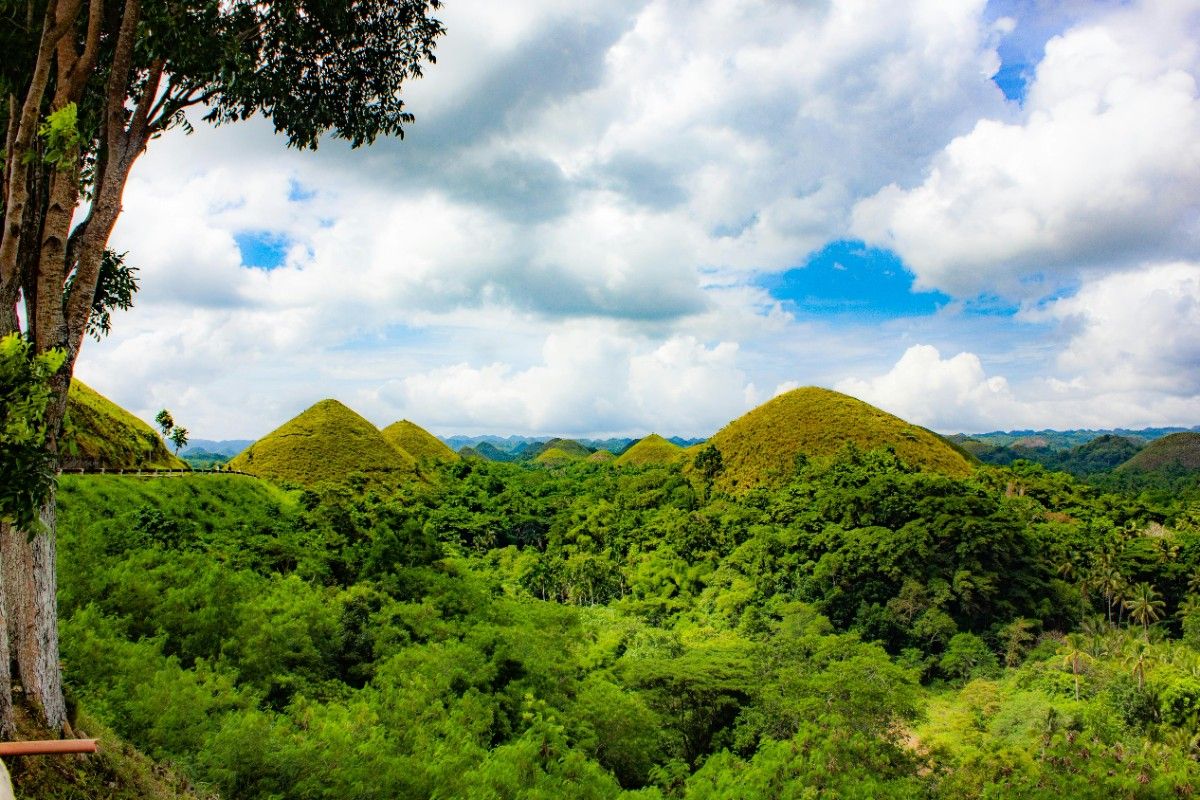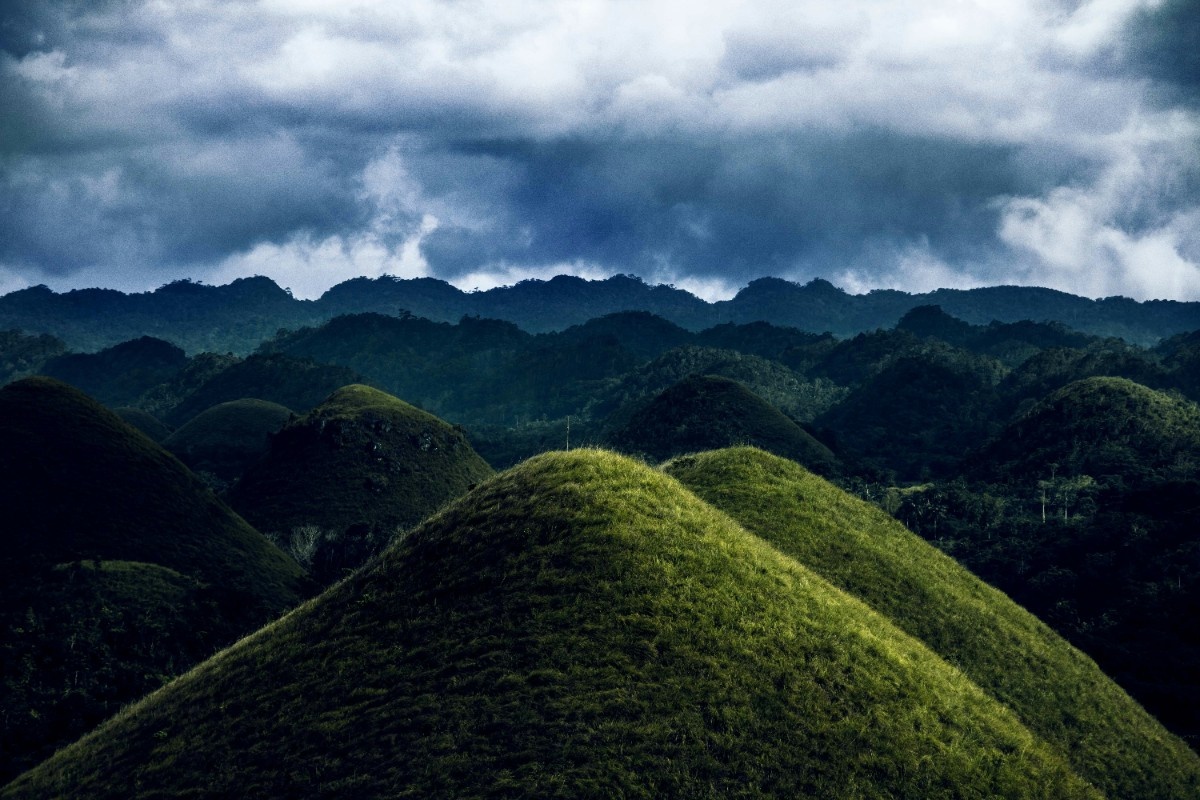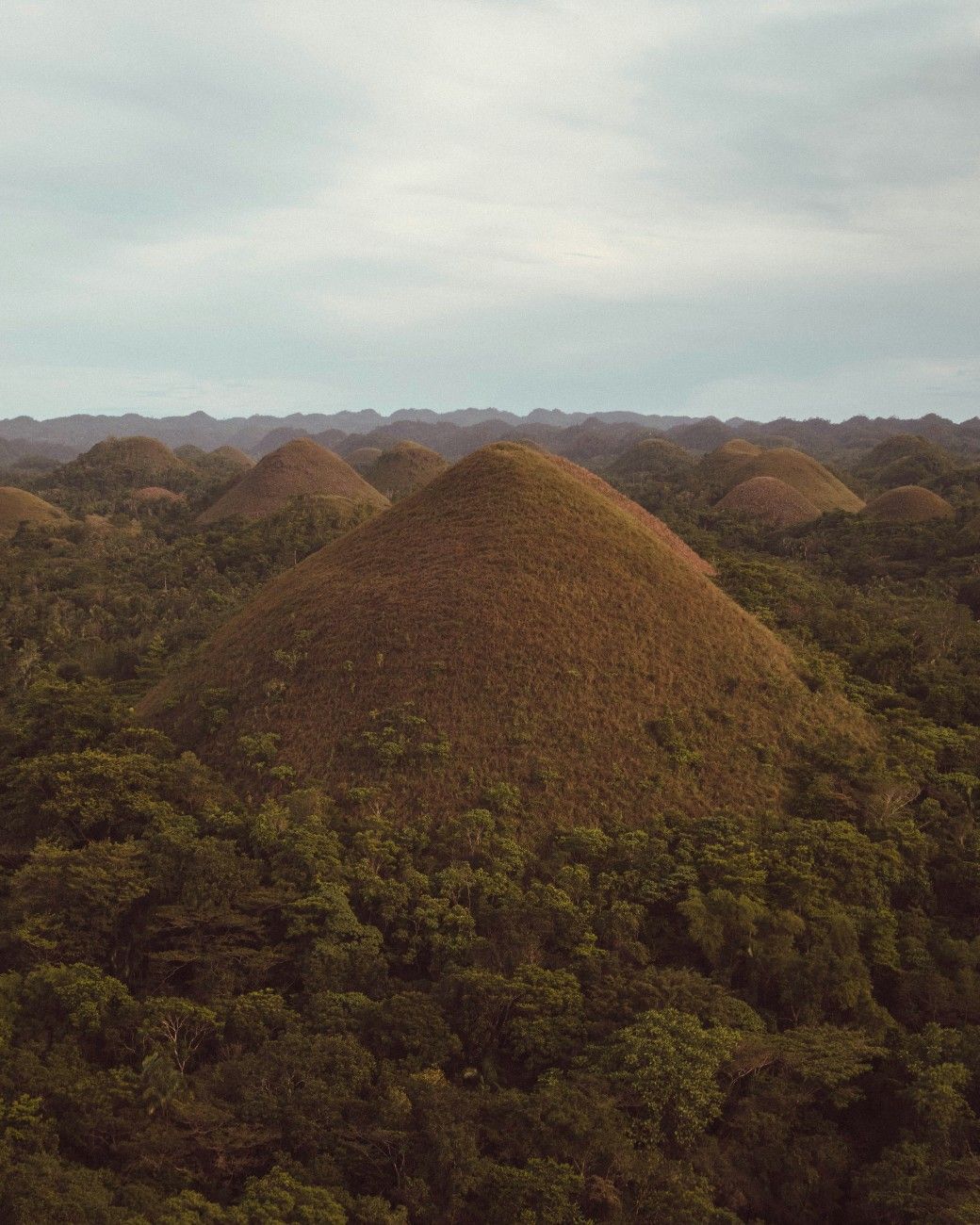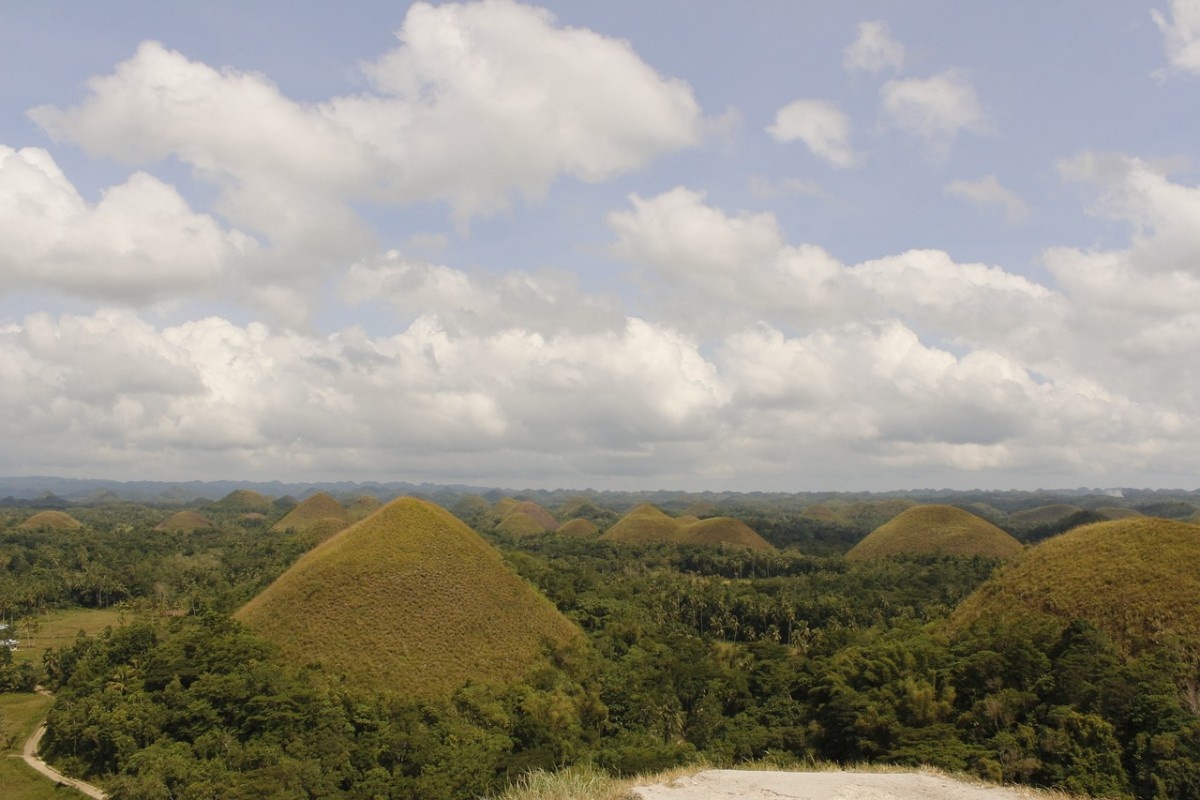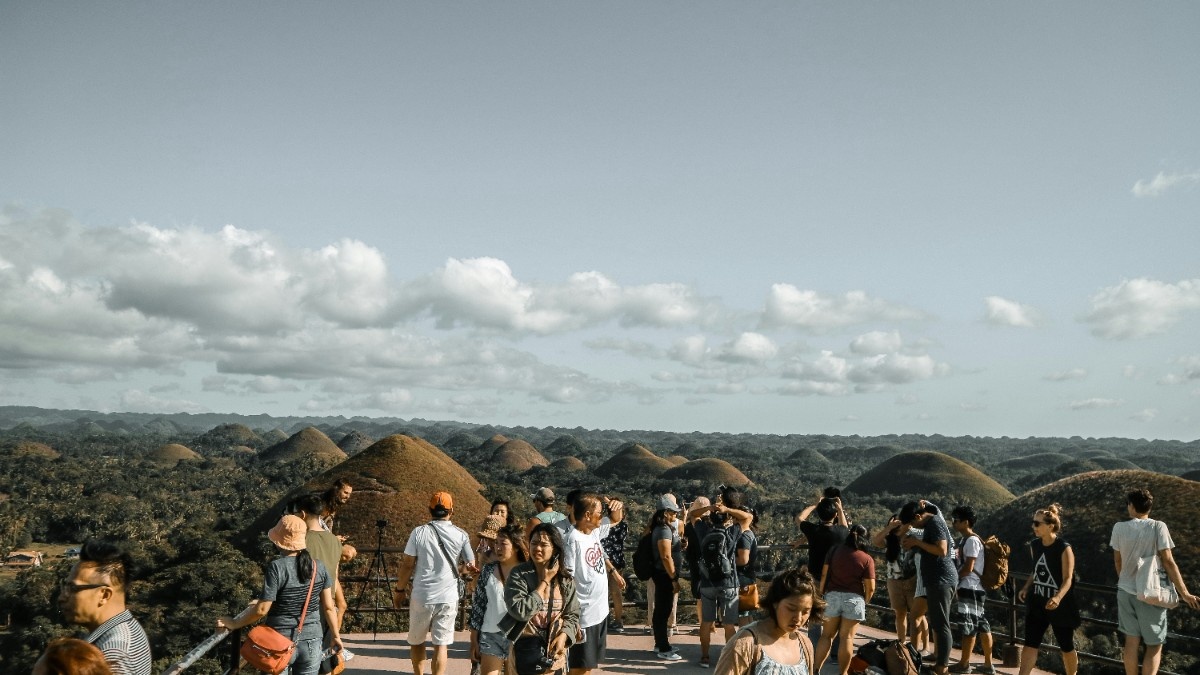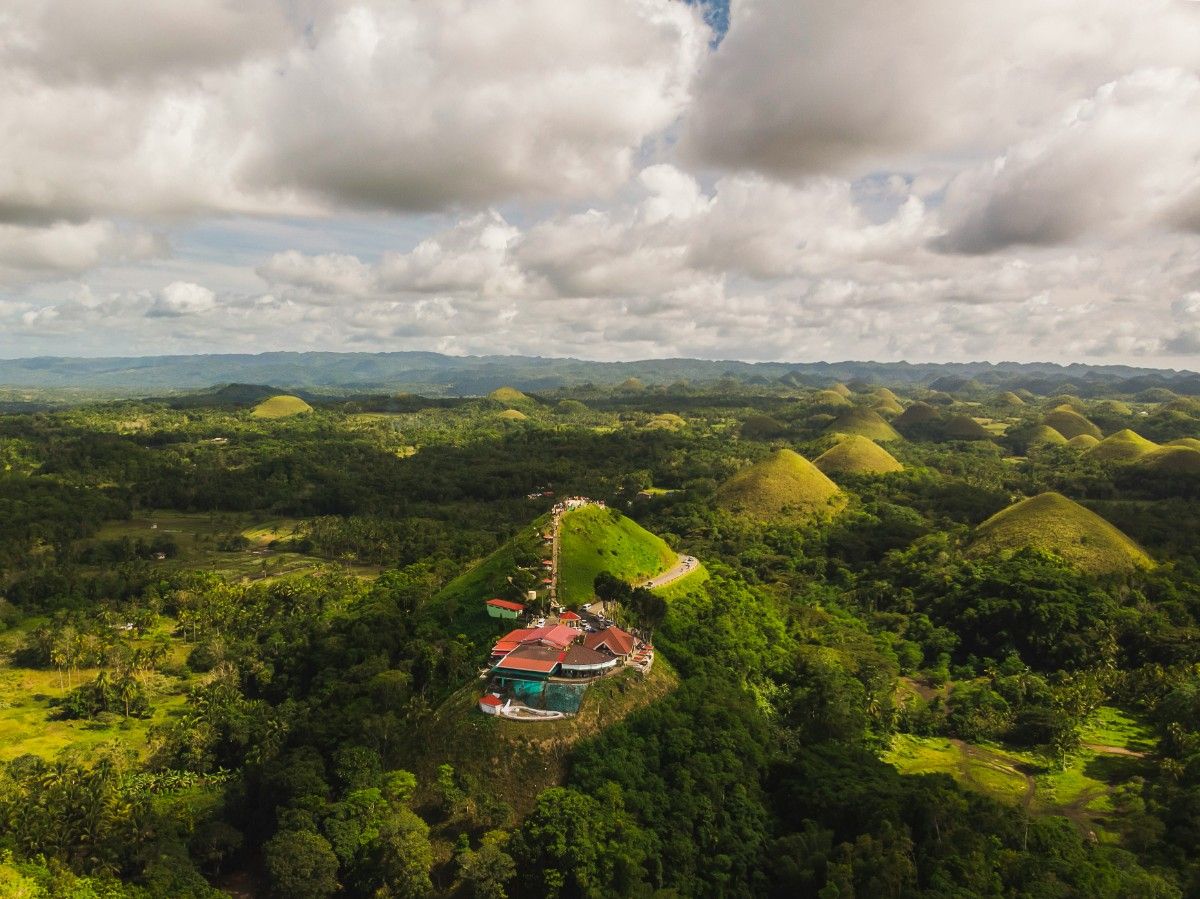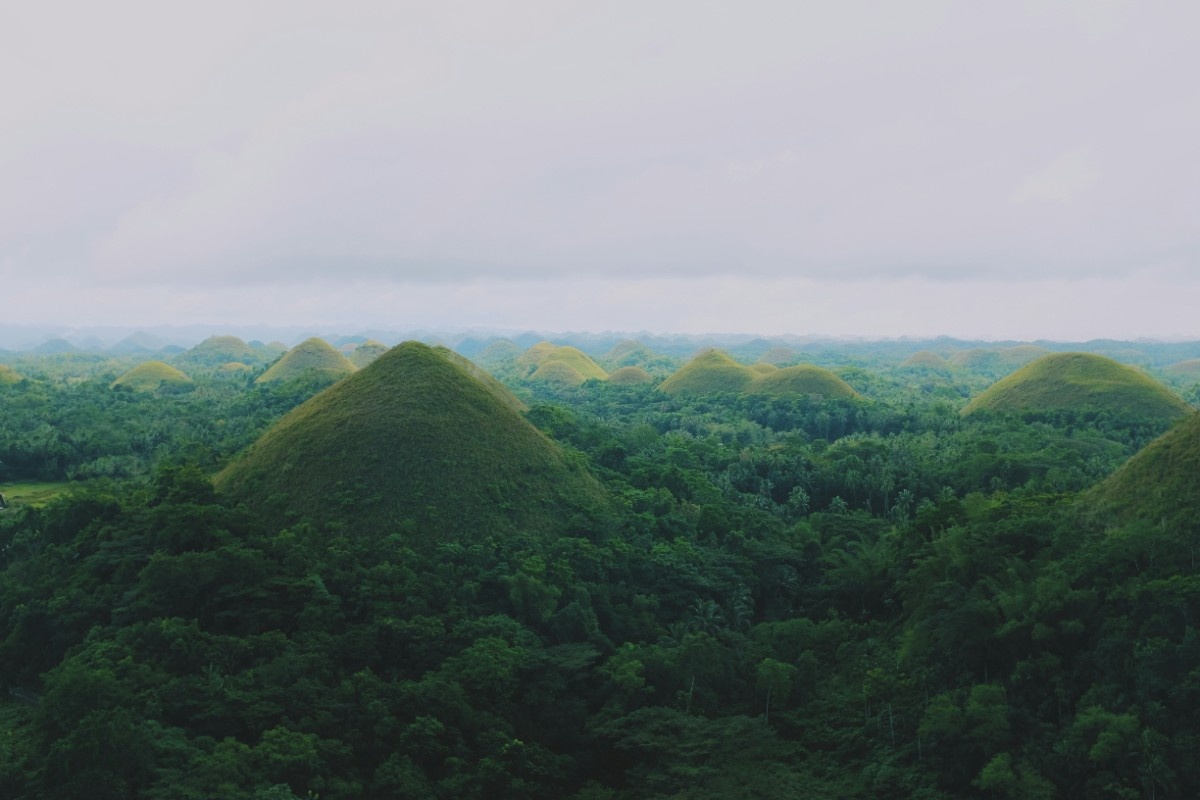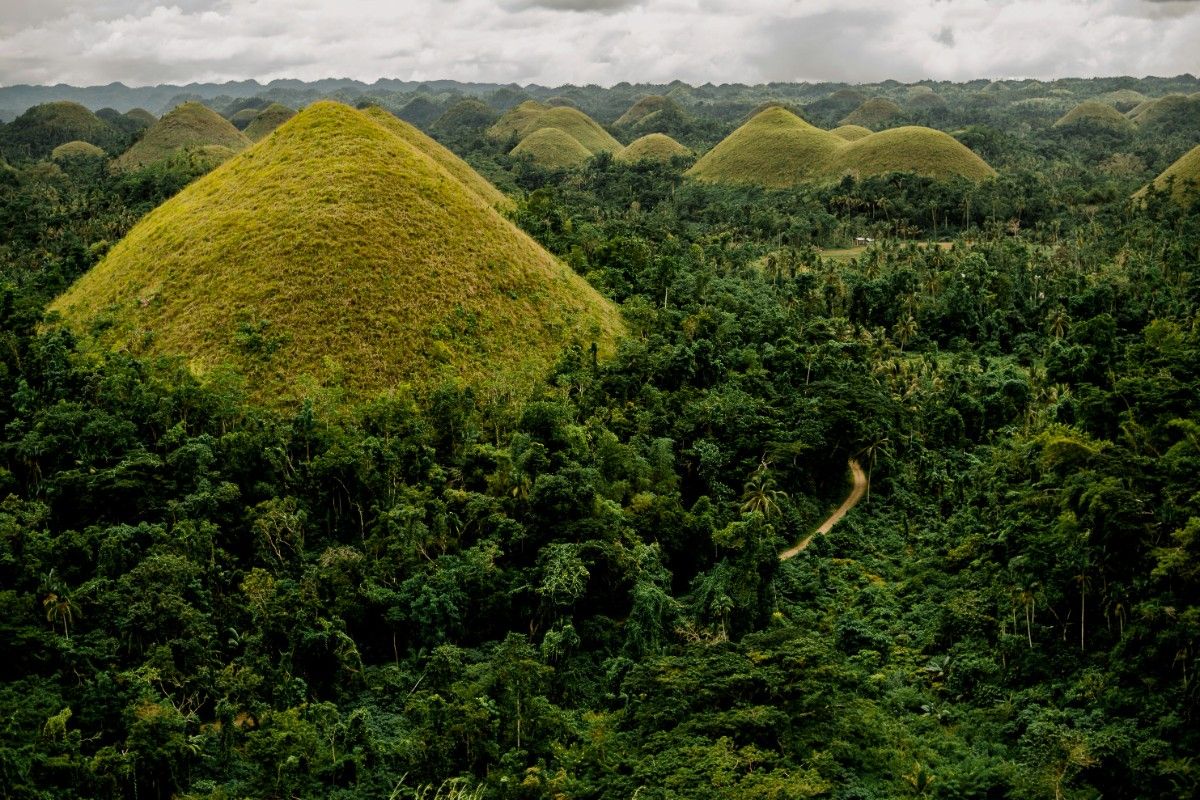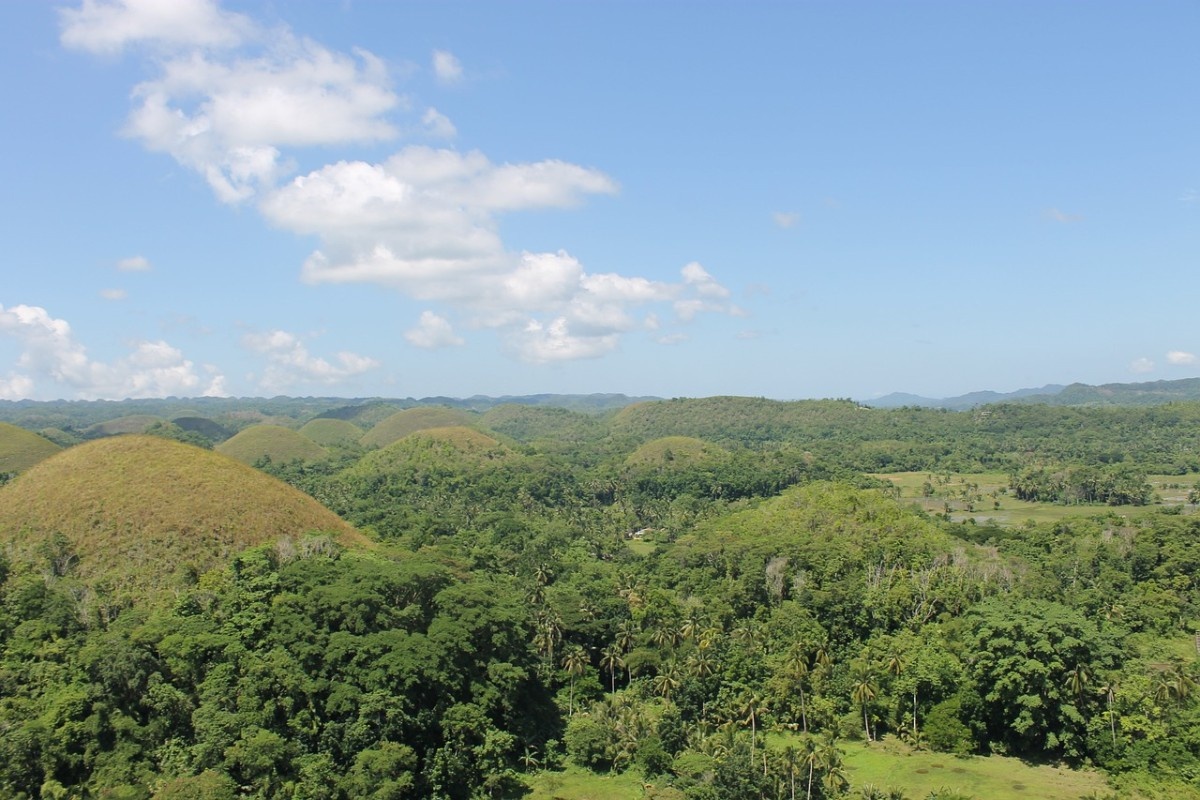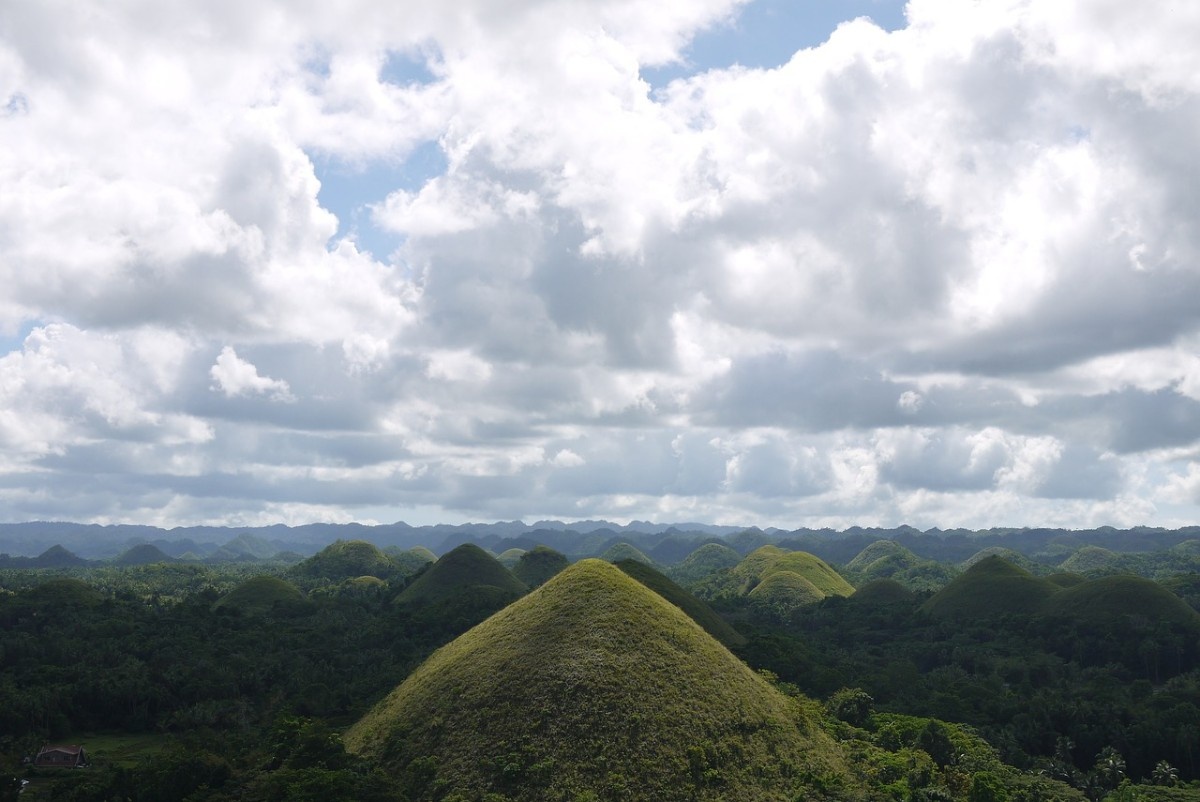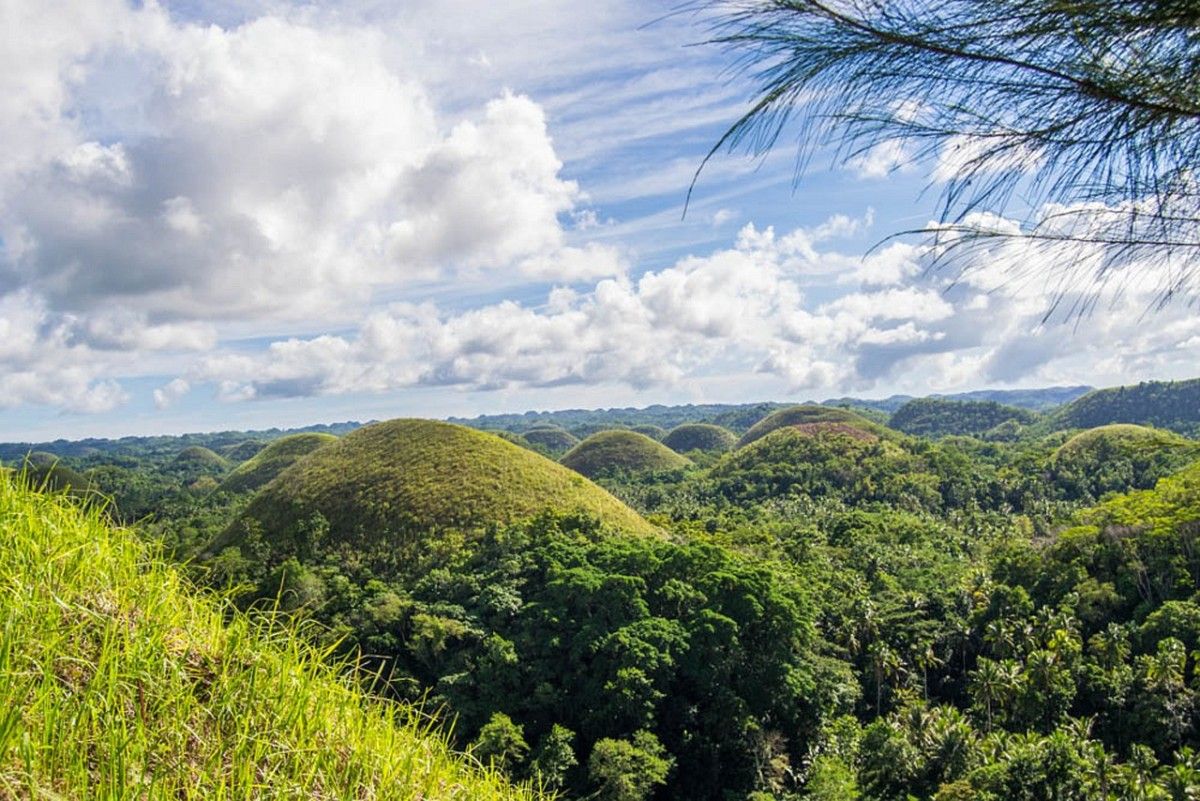Introduction to the Chocolate Hills, Bohol
Overview of the Chocolate Hills
The Chocolate Hills are a remarkable geological formation located in the heart of Bohol Island in the Philippines. These iconic hills have captured the imagination of locals and visitors alike, earning a well-deserved spot among the country's most beloved natural wonders. The Chocolate Hills of Bohol are a testament to the breathtaking beauty and unique landscapes found within the Philippine archipelago. The hills, which are spread across the municipalities of Carmen, Batuan, and Sagbayan in Bohol Province, are characterised by their distinct conical shape and uniform size, creating a mesmerising panorama that stretches as far as the eye can see. The name "Chocolate Hills" comes from the hills' appearance during the dry season when the grass covering the hills turns a rich chocolate brown, contrasting sharply with the lush green vegetation that blankets the surrounding valleys.
Significance of the Chocolate Hills as a Natural Wonder
The Chocolate Hills of the Philippines are not only visually striking but also a rare geological formation that has captivated the interest of scientists and nature enthusiasts worldwide. The hills are considered a prime example of karst topography, which is characterised by the dissolution of soluble rocks, such as limestone, resulting in unique landforms like sinkholes, caves, and conical hills. The Chocolate Hills of Bohol Island, with their uniform shape and distribution, are a particularly remarkable example of this type of landscape. The significance of the Chocolate Hills extends beyond their geological importance, as they also play a crucial role in the ecosystem of Bohol. The hills are home to a diverse array of flora and fauna, including several endemic species that are found nowhere else in the world. The preservation and protection of this natural wonder are of utmost importance, not only for the sake of the environment but also for the economic and cultural well-being of the local communities who have come to rely on the hills as a source of pride and livelihood through tourism.
Geological Formation and Composition of the Chocolate Hills
Geological Processes Involved in the Formation of the Chocolate Hills
The Chocolate Hills of Bohol, Philippines, are a fascinating example of the complex geological processes that have shaped the Earth's surface over millions of years. The formation of these iconic hills can be attributed to a combination of tectonic uplift, limestone deposition, and erosion. The story of the Chocolate Hills begins during the Late Pliocene to Early Pleistocene era, when the island of Bohol was still submerged beneath the sea. During this time, the remains of marine organisms, such as corals and molluscs, accumulated on the seafloor, gradually forming layers of limestone. As tectonic forces caused the land to rise above sea level, the limestone beds were exposed to the elements, setting the stage for the development of the Chocolate Hills. The emergence of the land allowed for the infiltration of rainwater, which began to dissolve the limestone through a process called karst dissolution. As the water seeped through cracks and fissures in the rock, it slowly eroded the limestone, creating a network of underground caves and sinkholes.
Composition and Characteristics of the Limestone
The Chocolate Hills of Bohol Province, Philippines, are primarily composed of limestone, a sedimentary rock formed from the accumulation and compression of calcium carbonate materials, such as the skeletal remains of marine organisms. Limestone is known for its porous nature and susceptibility to chemical weathering, particularly when exposed to slightly acidic rainwater. The limestone that makes up the Chocolate Hills is classified as a soft, fine-grained limestone, which is more easily eroded than harder, crystalline varieties. This softness, combined with the high porosity of the rock, has allowed for the rapid development of the hills' distinct conical shape through the process of dissolution and erosion. The composition of the limestone also plays a role in the unique vegetation patterns observed on the Chocolate Hills. The calcium-rich soils derived from the limestone bedrock support the growth of grass species that are particularly well-adapted to the dry conditions that prevail during the summer months. These grasses, which include imperata cylindrica and saccharum spontaneum, turn a rich chocolate brown during the dry season, giving the hills their iconic appearance and name.
Influence of Tectonic Activity and Uplift
The formation of the Chocolate Hills of Bohol Island, the Philippines, has been significantly influenced by the tectonic activity and uplift that have occurred in the region over millions of years. The island of Bohol, along with the rest of the Philippine archipelago, sits on the Philippine Mobile Belt, a complex tectonic zone characterised by the convergence of the Eurasian, Philippine Sea, and Indo-Australian plates. The interaction of these tectonic plates has resulted in the uplift and deformation of the land, exposing the limestone beds that would eventually give rise to the Chocolate Hills. The uplift of Bohol Island has occurred in several stages, with each phase contributing to the development of the hills. The initial uplift, which occurred during the Late Pliocene to Early Pleistocene era, brought the limestone beds above sea level, subjecting them to the erosional forces of wind and water. Subsequent uplift events, driven by the ongoing tectonic activity in the region, have further elevated the land, increasing the exposure of the limestone and accelerating the erosion process. The tectonic uplift has also played a role in the formation of the underground cave systems and sinkholes that are commonly associated with karst landscapes like the Chocolate Hills. As the land has risen, the water table has lowered, allowing for the development of extensive subterranean drainage networks that have contributed to the dissolution and erosion of the limestone bedrock.
Flora and Fauna of the Chocolate Hills
Unique Vegetation of the Chocolate Hills
The Chocolate Hills of Bohol, Philippines, are not only known for their stunning geological features but also for the unique flora that thrives in this remarkable landscape. The vegetation that covers the hills is primarily composed of grass species that have adapted to the calcium-rich soils and distinct dry and wet seasons of the region. The most prominent grass species found on the Chocolate Hills are imperata cylindrica and saccharum spontaneum, which are known for their resilience and ability to withstand the harsh conditions of the dry season. These grasses play a crucial role in maintaining the stability of the hills, as their extensive root systems help to bind the soil and prevent erosion. During the wet season, the grasses grow lush and green, covering the hills in a vibrant carpet of vegetation. As the dry season approaches, the grasses begin to turn brown, giving the Chocolate Hills of Bohol Province their distinctive chocolate-like appearance. In addition to the grass species, the Chocolate Hills are also home to a variety of other plants, including shrubs, herbs, and small trees. These plants have adapted to the unique conditions of the karst landscape, with many species developing special mechanisms to cope with the porous limestone soil and seasonal drought. Some notable plant species found in the area include the Puting Bato tree at the base of the hill, which is known for its ability to thrive in the calcium-rich soils, and various species of orchids and ferns that cling to the crevices and sinkholes of the limestone bedrock.
Diverse Fauna and Endemic Species
The Chocolate Hills of Bohol Island, the Philippines, and the surrounding areas are home to a diverse array of fauna, including several species that are endemic to the region. The unique karst landscape provides a variety of habitats, from the grassy slopes of the hills to the dense forests and underground cave systems, each supporting its own distinct community of animals. One of the most iconic and beloved species found in the Chocolate Hills is the Philippine tarsier, a small, nocturnal primate known for its large, expressive eyes and unique vocalisations. The tarsier, which is endemic to the Philippines and is considered a near-threatened species, finds refuge in the forests surrounding the Chocolate Hills, where it feeds on insects and small vertebrates. Other notable mammals found in the area include the Visayan warty pig, a critically endangered species that relies on the forests and grasslands around the hills for its survival, and the Philippine flying lemur, a nocturnal gliding mammal that is endemic to the Philippine archipelago. The Chocolate Hills of the Philippines also support a rich diversity of birdlife, with several endemic species calling the area home. The Visayan hornbill, a large, fruit-eating bird known for its distinctive casque, is one of the most iconic avian species found in the forests surrounding the hills. Other notable bird species include the Philippine eagle-owl, a powerful nocturnal predator, and the Visayan broadbill, a small, colourful bird that is endemic to the Visayan islands. The karst landscape of the Chocolate Hills also harbours a fascinating array of reptiles and amphibians, many of which are found nowhere else in the world. The Bohol monitor lizard, a large, carnivorous lizard that can grow up to two meters in length, is one of the most impressive reptilian inhabitants of the hills. The underground cave systems and sinkholes associated with the karst terrain also provide habitat for a variety of unique and endemic species, such as the Bohol limestone frog and the Philippine bent-toed gecko.
Cultural Significance and Local Legends
The Chocolate Hills in Boholano Folklore
The Chocolate Hills of Bohol, Philippines, hold a special place in the hearts and minds of the local Boholano people, with numerous legends and folktales surrounding their origin and significance. These stories, passed down through generations, offer a fascinating glimpse into the rich cultural heritage of the region and the deep connection between the people and their natural environment. One of the most famous legends associated with the Chocolate Hills of Carmen, Bohol, tells the story of two feuding giants named Arogo and Aloya. According to the tale, the two giants were locked in a bitter battle, hurling rocks and boulders at each other in a fierce display of strength and anger. As their fight raged on, the landscape became littered with the debris of their conflict, forming the iconic conical hills that we know today as the Chocolate Hills. In another popular legend, the Chocolate Hills are said to be the tears of a heartbroken giant named Dano. The story goes that Dano fell deeply in love with a mortal woman named Aluya, but their love was forbidden by the gods. When Aluya tragically died, Dano wept tears of grief, which fell upon the earth and hardened into the countless hills that now dot the landscape of Bohol. These legends not only provide entertaining and imaginative explanations for the formation of the Chocolate Hills but also serve to illustrate the deep cultural and emotional significance that the hills hold for the Boholano people. The stories are a testament to the enduring power of folklore and the way in which natural wonders can become interwoven with the identity and history of a community.
Cultural Practices and Celebrations
The Chocolate Hills of Bohol Province, Philippines, have long been a source of inspiration and pride for the local Boholano people, influencing various aspects of their cultural practices and celebrations. The unique landscape of the hills has shaped traditional art forms, such as painting, sculpture, and handicrafts, with many local artisans drawing upon the distinctive shape and colour of the hills in their work. In addition to inspiring artistic expression, the Chocolate Hills have also played a role in the development of local architecture and design. Traditional Boholano homes, known as "bahay kubo," often feature design elements that echo the conical shape of the hills, such as steeply pitched roofs and circular floor plans. These architectural details serve as a visual reminder of the deep connection between the Boholano people and their natural surroundings. One of the most important cultural events associated with the Chocolate Hills of Bohol Island, the Philippines, is the annual Chocolate Hills Festival, which takes place in the municipality of Carmen. This vibrant celebration, held in May, honours the iconic landscape and the rich cultural heritage of the Boholano people. During the festival, visitors can enjoy a variety of activities, including cultural performances, musical concerts, art exhibitions, and culinary demonstrations showcasing the unique flavours and ingredients of Boholano cuisine. The Chocolate Hills Festival also features a range of eco-tourism activities, such as guided hikes and nature walks, which allow visitors to explore the hills and learn about the diverse flora and fauna that call this remarkable landscape home. These activities not only provide a deeper appreciation for the natural beauty of the Chocolate Hills but also help to promote sustainable tourism practices that benefit both the environment and local communities. Through these cultural practices and celebrations, the Boholano people continue to honour and preserve the legacy of the Chocolate Hills, ensuring that this natural wonder remains a vital part of their identity and heritage for generations to come.
Tourism and Accessibility
Visiting the Chocolate Hills
The Chocolate Hills of Bohol, Philippines, have become one of the country's most popular tourist destinations, attracting visitors from around the world who are eager to witness the breathtaking beauty of this unique landscape. The hills, located in the heart of Bohol Island, are easily accessible from major cities in the Philippines, making them a convenient and compelling destination for both domestic and international travellers. Visitors to the Chocolate Hills can choose from a variety of transportation options, depending on their point of origin and personal preferences. The most common way to reach Bohol is by air, with daily flights connecting the island to major hubs like Manila and Cebu. The Bohol-Panglao International Airport, located just a short drive from the provincial capital of Tagbilaran City, serves as the main gateway to the island and the Chocolate Hills of Bohol Province, Philippines. Upon arriving in Bohol, visitors can reach the Chocolate Hills by road, with well-maintained highways and scenic routes leading to the main viewing areas. Many travellers opt to join guided tours, which often include round-trip transportation from their hotel or resort, as well as informative commentary from knowledgeable local guides. For those who prefer a more independent approach, rental cars and motorcycles are widely available, allowing visitors to explore the hills and the surrounding countryside at their own pace. The most popular spot to view the Chocolate Hills of the Philippines is the Chocolate Hills Complex, located in the municipality of Carmen, Bohol. This visitor centre offers stunning panoramic views of the hills from an elevated observation deck, providing the perfect vantage point to appreciate the scale and grandeur of the landscape. The complex also features a range of amenities, including a restaurant, souvenir shops, and a small museum showcasing the geological and cultural significance of the hills.
Accommodations and Eco-Tourism Activities
For those looking to fully immerse themselves in the natural beauty of the Chocolate Hills of Bohol Island, the Philippines, there are numerous accommodations and eco-tourism activities available in the surrounding area. Visitors can choose from a range of lodging options, from luxurious resorts to charming bed and breakfasts, many of which offer stunning views of the hills and the lush green countryside. One of the most popular ways to experience the Chocolate Hills is through guided hiking and trekking tours. These eco-friendly excursions allow visitors to explore the hills up close, discovering hidden viewpoints and learning about the unique flora and fauna that thrive in this remarkable landscape. Many of these tours are led by experienced local guides who are passionate about sharing their knowledge and love of the Chocolate Hills with visitors. In addition to hiking and trekking, there are plenty of other eco-tourism activities to enjoy in and around the Chocolate Hills. Visitors can go birdwatching, with the chance to spot some of the rare and endemic species that call the area home, or join a wildlife spotting tour to catch a glimpse of the elusive Philippine tarsier in its natural habitat. For those interested in the cultural heritage of the region, there are also opportunities to visit local villages and communities, where visitors can learn about traditional Boholano crafts, cuisine, and way of life. As tourism to the Chocolate Hills of Bohol Province, Philippines, continues to grow, local authorities and tourism operators are increasingly focused on promoting sustainable and responsible travel practices. This includes encouraging visitors to support locally-owned businesses, minimising their environmental impact, and contributing to conservation efforts aimed at preserving the natural beauty and biodiversity of the hills for future generations.
Conservation and Protection Efforts
Preserving the Natural Landscape
The Chocolate Hills of Bohol, Philippines, are not only a stunning natural wonder but also a fragile ecosystem that requires dedicated conservation and protection efforts to ensure its long-term survival. Recognising the ecological and cultural significance of the hills, local authorities, environmental organisations, and community groups have come together to implement various measures aimed at safeguarding this unique landscape for generations to come. One of the key initiatives in the conservation of the Chocolate Hills is the establishment of protected areas and nature reserves. The Chocolate Hills Natural Monument, which encompasses a significant portion of the hills and their surrounding landscapes, was declared a protected area in 1997 by the Philippine government. This designation helps to ensure that the hills and their ecosystems are shielded from harmful human activities, such as quarrying, illegal logging, and unsustainable agricultural practices. By reducing these threats, the protected area status allows for the natural processes that shape the Chocolate Hills of Bohol Island, the Philippines, to continue unimpeded, maintaining the hills' iconic appearance and ecological integrity. In addition to legal protections, conservation efforts in the Chocolate Hills also focus on promoting sustainable land management practices in the surrounding areas. This includes working with local farmers and landowners to encourage the adoption of eco-friendly farming techniques, such as organic agriculture and agroforestry, which help to reduce soil erosion, maintain soil fertility, and protect the water resources that are vital to the health of the hills and their ecosystems. These sustainable practices not only contribute to the conservation of the Chocolate Hills of the Philippines but also provide economic benefits to local communities, ensuring that the protection of the natural landscape goes hand in hand with the well-being of the people who call this region home.
Engaging Local Communities and Raising Awareness
Effective conservation and protection of the Chocolate Hills of Bohol, Philippines, require the active engagement and participation of local communities. Recognising this, environmental organisations and government agencies have been working to raise awareness about the importance of the hills and to involve Boholano communities in the stewardship of their natural heritage. One of the key strategies for engaging local communities is through environmental education and outreach programs. These initiatives aim to foster a deeper understanding and appreciation of the Chocolate Hills and their ecosystems among Boholanos, particularly young people. By organising school visits, community workshops, and nature camps, conservationists hope to inspire a new generation of environmental stewards who will take an active role in protecting and preserving the hills for years to come. Another important aspect of community engagement is the promotion of sustainable livelihoods that are compatible with the conservation of the Chocolate Hills of Carmen, Bohol. This includes supporting the development of eco-tourism initiatives, such as guided hiking tours and homestays, which allow local communities to benefit economically from the natural beauty of the hills while also contributing to their protection. By providing alternative sources of income that do not rely on environmentally destructive practices, these initiatives help to reduce pressure on the hills and their ecosystems. In addition to working directly with local communities, conservation efforts in the Chocolate Hills also focus on raising awareness about the importance of this natural wonder among the wider public. Through media campaigns, educational exhibits, and public events, environmental organisations and government agencies aim to generate greater support for the protection of the hills and to encourage more people to get involved in conservation efforts. By building a strong base of public support, conservationists hope to ensure that the Chocolate Hills of Bohol Province, Philippines, will continue to be cherished and protected for generations to come.
Sustainable Tourism and Community Development
Balancing Tourism Growth and Environmental Conservation
As the Chocolate Hills of Bohol, Philippines, continue to attract an increasing number of visitors from around the world, it is crucial to develop and implement sustainable tourism practices that balance economic growth with environmental conservation. By prioritising sustainability, local authorities and tourism stakeholders aim to ensure that the benefits of tourism are maximised while minimising the negative impacts on the delicate ecosystems and cultural heritage of the region. One of the key aspects of sustainable tourism in the Chocolate Hills is the development of eco-friendly infrastructure and accommodations. This involves the construction of lodges, resorts, and other tourist facilities that are designed to blend harmoniously with the natural landscape, using locally sourced materials and incorporating green building practices such as solar power, rainwater harvesting, and waste management systems. By adopting these sustainable design principles, tourism developments in the area can reduce their ecological footprint and demonstrate that it is possible to provide high-quality visitor experiences while also respecting and preserving the environment. Another important element of sustainable tourism in the Chocolate Hills of Bohol Province, Philippines, is the promotion of responsible visitor behaviour. This includes educating tourists about the importance of the hills and their ecosystems, and encouraging them to adopt practices that minimise their impact on the environment, such as proper waste disposal, avoiding littering, and staying on designated trails. By fostering a culture of environmental stewardship among visitors, sustainable tourism initiatives can help to ensure that the Chocolate Hills remain a pristine and awe-inspiring destination for generations to come. To further support the conservation of the Chocolate Hills of the Philippines, sustainable tourism practices also involve the development of partnerships between tourism operators, local communities, and environmental organisations. By working together, these stakeholders can identify and address the challenges facing the hills, such as soil erosion, invasive species, and climate change impacts, and develop collaborative solutions that benefit both the environment and local livelihoods. These partnerships can also facilitate the sharing of knowledge and best practices, enabling the continuous improvement of sustainable tourism strategies in the region.
Empowering Local Communities through Tourism
Sustainable tourism in the Chocolate Hills of Bohol Island, the Philippines, not only seeks to protect the natural environment but also aims to empower and benefit local communities. By creating opportunities for Boholanos to participate in and profit from the tourism industry, sustainable tourism initiatives can contribute to poverty alleviation, improve quality of life, and foster a sense of pride in the region's natural and cultural heritage. One of the primary ways in which sustainable tourism empowers local communities is through the creation of employment opportunities. As the tourism industry grows in the Chocolate Hills, there is an increasing demand for skilled workers in various sectors, such as hospitality, guiding, and transportation. By providing training and capacity-building programs, sustainable tourism projects can help local residents acquire the necessary skills to take advantage of these job opportunities, enabling them to earn a stable income and improve their economic well-being. In addition to direct employment, sustainable tourism also supports the development of local entrepreneurship. By encouraging the growth of small and medium-sized enterprises that cater to the needs of tourists, such as restaurants, souvenir shops, and tour operators, sustainable tourism initiatives help to stimulate the local economy and create a more diverse and resilient economic base. This, in turn, can lead to increased income levels, improved living standards, and greater economic stability for Boholano communities. Sustainable tourism in the Chocolate Hills of Bohol, Philippines, also places a strong emphasis on community involvement and participation. By engaging local residents in the planning and decision-making processes related to tourism development, sustainable tourism projects ensure that the needs and concerns of the community are taken into account. This participatory approach not only helps to build trust and support for tourism initiatives but also empowers local communities to take an active role in shaping the future of their region. Moreover, by promoting community-based tourism initiatives, such as homestays and cultural tours, sustainable tourism in the Chocolate Hills provides opportunities for Boholanos to share their traditional knowledge, customs, and way of life with visitors, fostering cross-cultural understanding and preserving the rich cultural heritage of the region.
Conclusion and Future Outlook
The Enduring Legacy of the Chocolate Hills
The Chocolate Hills of Bohol, Philippines, stand as a testament to the awe-inspiring beauty and geological wonders that the country has to offer. These iconic hills, sculpted by millions of years of natural processes, have captured the hearts and imaginations of countless visitors, becoming a symbol of Bohol's rich natural heritage and a source of pride for the Filipino people. Beyond their stunning visual appeal, the Chocolate Hills of Bohol Province also serve as a vital ecosystem, supporting a diverse array of flora and fauna, including many endemic species found nowhere else on Earth. The unique landscape and its associated biodiversity highlight the importance of conservation efforts aimed at protecting this fragile environment for future generations. As sustainable tourism practices and community-based initiatives continue to gain momentum in the region, the Chocolate Hills serve as a shining example of how economic development and environmental stewardship can go hand in hand. By prioritising the well-being of both the natural world and local communities, Bohol is setting a precedent for responsible tourism that can inspire other destinations around the globe. The enduring legacy of the Chocolate Hills extends far beyond their status as a popular tourist attraction. These majestic mounds are a testament to the resilience and adaptability of the Boholano people, who have lived in harmony with this landscape for generations. The hills are intertwined with the cultural identity of the region, as evidenced by the numerous legends and folkloric tales that have been passed down through the ages. As we look to the future, it is clear that the Chocolate Hills of Bohol Island, the Philippines, will continue to captivate and inspire visitors from all walks of life. By safeguarding this natural treasure and promoting sustainable development practices, we ensure that the hills will endure as a beacon of hope and wonder for generations to come.
Looking to the Future
As we ponder the future of the Chocolate Hills of Carmen, Bohol, it is evident that the coming years will bring both challenges and opportunities. Climate change, growing tourist numbers, and the ever-present need for economic development will undoubtedly put pressure on this fragile ecosystem. However, with the right strategies and a commitment to sustainability, there is every reason to believe that the Chocolate Hills will continue to thrive. Ongoing research and scientific study will play a crucial role in understanding the complex dynamics of the hills and their surrounding landscapes. By deepening our knowledge of the geological processes, ecological interactions, and climate patterns that shape this unique environment, we will be better equipped to develop effective conservation and management strategies. This research will also help to identify new opportunities for sustainable tourism and community development, ensuring that the benefits of the Chocolate Hills of the Philippines are shared equitably among all stakeholders. As global awareness of the importance of preserving our planet's natural wonders grows, the Chocolate Hills will undoubtedly serve as a powerful symbol of the need for responsible stewardship of the Earth's resources. By showcasing the successful collaboration between conservation organisations, local communities, and the tourism industry, the hills can inspire similar initiatives in other parts of the Philippines and beyond. Ultimately, the future of the Chocolate Hills of Bohol, Philippines, will be shaped by the actions and choices we make today. By embracing sustainable practices, fostering a deep appreciation for the natural world, and working together to protect this extraordinary landscape, we can ensure that the Chocolate Hills will continue to inspire and delight visitors for generations to come. In doing so, we not only safeguard a priceless natural heritage but also create a brighter, more sustainable future for all.
Related Articles

Let us know you agree to cookies
We use marketing, analytical and functional cookies as well as similar technologies to give you the best experience. Third parties, including social media platforms, often place tracking cookies on our site to show you personalised adverts outside of our website.
We store your cookie preferences for two years and you can edit your preferences via ‘manage cookies’ or through the cookie policy at the bottom of every page. For more information, please see our cookie policy.
